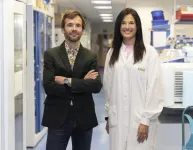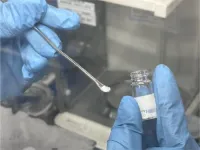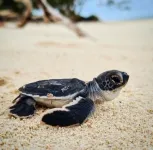(Press-News.org) Researchers at the RIKEN Cluster for Pioneering Research (CPR) have developed technology that can alter, within the body, the recognized identity of proteins. The innovation, published in Nature Communications on October 2, allowed researchers to target mouse tumors with a protein and then transport that protein out of the body. This means that cancer-killing drugs could be sent directly to tumors and then excreted from the body after dropping off their payload. The technology also has the potential to allow multi-purpose drugs that can travel from organ to organ, performing separate actions at each location.
Proteins in the blood travel all over the body, making them ideal carriers for targeted treatments against diseases like cancer. To avoid harming untargeted tissue, the drugs need to do their damage by attaching to the correct cells, and this requires a complicated molecular ID card. The new study led by Katsunori Tanaka at RIKEN CPR focuses on changing the identification markers on the surface of the albumin, the most abundant protein in the blood, thus changing which tissues it can attach to in the mouse body.
In a previous study, Tanaka’s team examined cancer-targeting capabilities of different identification-marking molecules — called glycans — that they attached to albumin. They found that identification pattern ‘A’ could bind to human colon cancer, as well as be transported to the bladder for excretion in urine, while identification pattern ‘B’ caused albumin to be picked up by the liver, sent to the intestines, and excreted from there.
The key innovation of the new study was figuring out how to change albumin’s molecular ID card after it reaches its destination inside the body. To achieve this, the researchers used the chemical click-to-release method. First, they created albumin-1 by attaching identification pattern ‘A’ to albumin. Then, they devised a switching carrier and its partner. The switcher carried identification pattern ‘B’ and the partner was attached to albumin-1. When the partner on albumin-1 met the switcher in a dish, the click-to-release reaction took place—‘B’ identifiers were clicked on and many of the ‘A’ identifiers were released. The new albumin was called albumin-2 and was a mix of identification patterns ‘A’ and ‘B’.
In the first proof-of-concept experiment in the mouse body, they labeled albumin-1 with a fluorescent protein and then injected it into the mouse blood stream with or without the switcher. As predicted, when injecting albumin-1 with the switcher, researchers observed fluorescence in the intestines, similar to what they observed after injecting albumin-2. Without the switcher, fluorescence was only seen in the blood, bladder, and urine.
Having shown that they could indeed alter the surface identity of albumin inside the body, the team next tested whether they could send albumin-1 into a tumor, and then remove it via the intestines, mimicking drug delivery and removal. They injected albumin-1 into mouse colon tumors, with or without the switcher after a short 10 min delay. In both cases, they observed albumin attaching to tumor cells. After injecting the switcher, albumin changed identity and much of it had moved from the tumor to the intestines within 5 hours. Without the switcher, albumin-1 never made it to the intestines.
The biocompatible reactions used by the new technology make it particularly attractive, and the new technique could revolutionize treatment for multiple conditions. “Our strategy could be used as a drug delivery system to promote excretion of a drug or medical radionuclide from a tumor after treatment,” explains Tanaka, “thereby preventing prolonged exposure that could lead to adverse effects. Alternatively, a single “patrolling” molecule could be used for simultaneous treatment of multiple diseases — as in the technology depicted in the movie Fantastic Voyage.”
END
Planning a drug’s route in the body with synthetic chemistry
2024-10-02
ELSE PRESS RELEASES FROM THIS DATE:
Smoke from megafires puts orchard trees at risk
2024-10-02
Smoke From Megafires Puts Orchard Trees at Risk
Effects Last Months, Reducing Nut Crop Yields
By Amy Quinton | October 2, 2023
Long-term smoke exposure from massive wildfires lowers the energy reserves of orchard trees and can cut their nut production by half, researchers at the University of California, Davis, found. The smoke can affect trees for months after a megafire, depressing their bloom and the next season’s harvest. This finding reveals a new danger from wildfires that could affect plant health in both agricultural and natural environments.
Nature Plants published ...
Health Data Research UK and National Research Foundation Singapore formalize landmark partnership in health data science
2024-10-02
Health Data Research UK (HDR UK) and the National Research Foundation Singapore (NRF) are pleased to have signed a Memorandum of Understanding (MoU) today, that formalises a collaborative partnership in healthcare and data science. The partnership will leverage cutting-edge data science and research, with a focus on trustworthy data use to power improvements in healthcare, research and innovation, strengthening existing links between the UK and Singapore.
The MoU was signed by Permanent Secretary for National Research and ...
CNIO researchers propose a new treatment for brain metastasis based on immunotherapy
2024-10-02
CNIO researchers have discovered that cancer perverts certain brain cells, the astrocytes, and causes them to produce a protein that works in favour of the tumour.
A drug, silibinin, inhibits this protein, and could be used to help treat brain metastasis with immunotherapy. A clinical trial is underway.
The work is published in the American Association for Cancer Research's journal Cancer Discovery.
Researchers at the Spanish National Cancer Research Centre (CNIO) propose a new treatment for brain metastases that respond poorly, or not at all, to immunotherapy, and provide a biomarker to predict ...
Discovery of promising electrolyte for all-solid-state batteries
2024-10-02
Often overlooked, rechargeable batteries play an important part in contemporary life, powering small devices like smartphones to larger ones like electric vehicles. The keys to creating sustainable rechargeable batteries include having them hold their charge longer, giving them a longer life with more charging cycles, and making them safer. Which is why there is so much promise in all-solid-state batteries.
The problem so far is discovering which solid electrolytes offer such potential advantages.
In a step toward that goal, an Osaka Metropolitan University research group led by Assistant Professor Kota Motohashi, Associate Professor Atsushi Sakuda, ...
One-minute phone breaks could help keep students more focused in class and better in tests
2024-10-02
Phones can be useful tools in classrooms to remind students of deadlines or encourage more exchange between students and teachers. At the same time, they can be distracting: Students report using their phones for non-academic purposes as often as 10 times a day. Thus, in many classrooms, phones are not allowed.
Now, researchers in the US have investigated if letting students use their phones for very brief amounts of time – dubbed phone or technology breaks – can enhance classroom performance and reduce phone use.
“We show that technology breaks may be helpful for reducing cell phone use in the college classroom,” said Prof Ryan Redner, a ...
New study identifies gaps in menopause care in primary care settings
2024-10-02
CLEVELAND, Ohio (Oct 2, 2024)—Timely identification and treatment of bothersome hot flashes have the potential to improve the lives of many women and save employers countless days of related absenteeism and lost work productivity. Yet, a new study finds that such symptoms are often not documented in electronic health records (EHRs) or not adequately addressed during primary care visits. The study is published online today in Menopause, the journal of The Menopause Society.
Approximately 75% of women experience hot flashes as they go through the menopause transition. Despite the common occurrence of these bothersome ...
Do coyotes have puppy dog eyes? New study reveals wild canines share dog's famous expression
2024-10-02
New research from Baylor University reveals that coyotes, like domestic dogs, have the ability to produce the famous "puppy dog eyes" expression. The study – "Coyotes can do 'puppy dog eyes' too: Comparing interspecific variation in Canis facial expression muscles," published in the Royal Society Open Science – challenges the hypothesis that this facial feature evolved exclusively in dogs as a result of domestication.
The research team, led by Patrick Cunningham, a Ph.D. research student in the Department ...
Scientists use tiny ‘backpacks’ on turtle hatchlings to observe their movements
2024-10-02
New research suggests that green turtle hatchlings ‘swim' to the surface of the sand, rather than ‘dig’, in the period between hatching and emergence. The findings have important implications for conserving a declining turtle population globally.
Published today in Proceedings B, scientists from UNSW’s School of Biological, Earth and Environmental Sciences, used a small device, known as an accelerometer, to uncover novel findings into the behaviours of hatchlings as they emerge from their nests.
Sea turtle eggs are buried in nests 30 – 80cm deep. Once hatched, the newborn turtles make their way to the surface ...
Snakes in the city: Ten years of wildlife rescues reveal insights into human-reptile interactions
2024-10-02
A new analysis of a decade-long collection of wildlife rescue records in NSW has delivered new insights into how humans and reptiles interact in urban environments.
Researchers from Macquarie University worked with scientists from Charles Darwin University, and the NSW Department of Climate Change, Energy, the Environment and Water to analyse over 37,000 records of snake and lizard rescues in the Greater Sydney region between 2011 and 2021.
Their study, Interactions between reptiles and people: a perspective from wildlife rehabilitation records is published in the journal Royal Society Open Science on Wednesday 2 October.
Lead author Teagan Pyne, ...
Costs of fatal falls among US older adults trump those attributed to firearm deaths
2024-10-01
The cost of fatal falls among older people (45-85+) trump those of firearm deaths in the US, finds research published in the open access journal Trauma Surgery & Acute Care Open.
The stark economics and shifting age demographics in the US underscore the urgency of preventive measures, conclude the researchers.
Falls account for around 1 in 5 of all injury-related hospital admissions, and the World Health Organization reports that falls are the second leading cause of unintentional injury deaths worldwide, with the over 65s especially vulnerable, highlight the researchers.
Like falls, firearms related injuries ...


